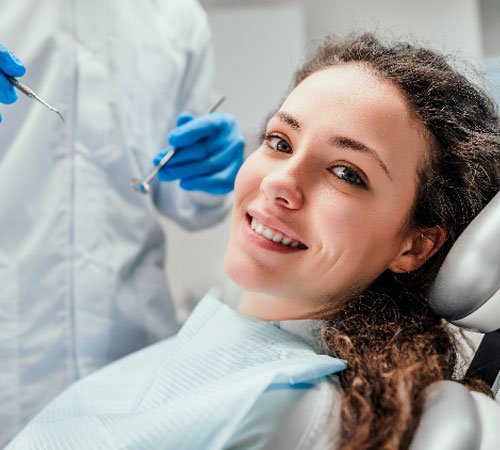Invisalign® Costs
 Invisalign® can be an attractive alternative to traditional metal braces. Patients of all ages appreciate that Invisalign® aligners are discreet thanks to manufacturers creating them with clear plastic material. Invisalign® also offers greater flexibility since patients can remove the aligners when necessary, such as when eating, brushing their teeth, or for a special occasion.
Invisalign® can be an attractive alternative to traditional metal braces. Patients of all ages appreciate that Invisalign® aligners are discreet thanks to manufacturers creating them with clear plastic material. Invisalign® also offers greater flexibility since patients can remove the aligners when necessary, such as when eating, brushing their teeth, or for a special occasion.
Wearing Invisalign® aligners on the top and bottom rows of teeth can also be more comfortable than having metal brackets and wires affixed to the teeth. The aligners apply the same pressure on the teeth to move as their metal counterparts do, and the total treatment time is often less. However, we cannot say with certainty that you would wear Invisalign® aligners for less time than standard braces. Every patient has varying levels of severity when it comes to tooth misalignment.
How Invisalign® Works
Before starting treatment at Orthodontic Specialists, Dr. Jeffrey Thompson takes X-rays of your teeth, gums, and jaws to help plan your Invisalign® treatment. He also takes a mold of your top and bottom rows of teeth, which involves you sitting in the dental chair with a tray filled with dental putty over each row of teeth. Our laboratory uses information from your X-rays and molds to create a customized set of Invisalign® aligners.
Approximately once every two weeks, you swap out your current aligner for a new one. Each customized aligner applies pressure to your teeth to shift into a new position. You should plan to wear your Invisalign® aligners at least 22 hours a day for the fastest and most accurate results.
Who is a Good Candidate for Treatment with Invisalign®?
Keep in mind that Invisalign® is not appropriate for all patients. Below are the most common orthodontic issues that respond well to regular use of Invisalign® aligners.
- Crossbite: A crossbite occurs due to misalignment of the upper and lower jaws. The misalignment causes some of the upper teeth to rest inside the lower teeth.
- Crowded teeth: When teeth are crooked, or there is not enough room in the mouth for all the teeth to grow in properly, Dr. Thompson may need to extract one or more teeth before you start orthodontic treatment.
- Mild relapse: Patients who wear traditional braces sometimes experience a slight relapse where the teeth start shifting back toward their pre-treatment position. Wearing Invisalign® aligners for a short time helps reverse this.
- Overbite: Also caused by misalignment of the upper and lower jaws, an overbite causes the top row of teeth to jut out further than normal from the lower row of teeth.
- Too much space between teeth, especially the front two teeth.
We will let you know if you are a good candidate for Invisalign® when you come in for your initial consultation.
Does Insurance Cover Invisalign® Treatment?
Most dental insurance companies offer at least some coverage for orthodontic treatment, often with several exceptions. The patient may need to be under a certain age, typically 18 years old, to receive benefits. Some insurance providers may not cover Invisalign® at all since it tends to cost more than traditional metal braces.
We encourage you to ask your dental insurance provider for an estimate of benefits before starting orthodontic treatment. We will also give you a written estimate of Invisalign® costs in Bradenton, FL, after applying the insurance discount to help you budget for treatment.
How Much Does Invisalign® Cost?
The cost of Invisalign® can vary significantly based on your overall oral health, the severity of your orthodontic problems, how long you wear the aligners, and how much insurance contributes to your treatment. According to The Consumer Guide to Dentistry, Invisalign costs run from $3,000 on the low end to $9,000 on the high end. Fortunately, you have several options to pay for orthodontic treatment if your out-of-pocket costs are high.
Use Funds from Your Flexible Savings Account or Health Savings Account
If your employer offers a Flexible Savings Account (FSA), you can contribute up to $2,400 to it annually as of January 1, 2024. You can withdraw money from your FSA on a tax-free basis to pay for orthodontic treatment, dental costs, and certain medical costs.
A Health Savings Account (HSA) gives you more money to work with than an FSA. Participants with a family can set aside up to $8,300 per year, while single people can contribute up to $4,150 to their HSA account. You need to have a high-deductible medical and dental insurance plan to meet the eligibility requirements for an HSA. As with an FSA, you can withdraw funds from the account tax-free to pay for certain dental and medical expenses.
Use or Apply for a No-Interest Credit Card for Dental Expenses
CareCredit is one of several credit cards that offer extended payment plans with no interest for out-of-pocket expenses such as Invisalign treatment, cosmetic surgery, or eyeglasses. Depending on your balance, you may be able to set up interest-free payments for six, 12, or 18 months. Just be sure to pay the balance in full within the established time to avoid having interest added to the account later.
Speak to Us About Any Financial Concerns
Orthodontic Specialists understand that Invisalign® costs in Bradenton, FL, are a legitimate concern for many patients. We are a family-owned practice and consider patients part of our extended family. Please ask about setting up a payment plan or referrals to other sources of financing to ensure that you can receive the care you need.





